Introduction
The great pyramids of Egypt and particularly those in Giza have raised more questions on how they were constructed than answers. The manner in which they were constructed is yet to be understood, and every now and then theories spring up to make some explanations. Some of the theories have even proposed that the giant structures were constructed with support from extraterrestrial beings. No single theory explains concisely how these structures were built and thus the pyramids still remain a mystery today. In this article, I will examine two of the theories which have been forward to explain in part the construction of the pyramids. However, I will start by explaining why the construction of the pyramids is a mystery. Lastly, a conclusion is drawn.
A Mystery
The mystery of the pyramids stems from their gigantic sizes, and the mathematical and structural engineering dimensions which they were constructed with. As at the time of the construction, modern geometry and structural engineering skills that have been discovered to have been used in the construction were not yet known. Constructing a pyramid and ensuring that the four walls meet at a point in a uniform manner is in itself a great feat. The Great Pyramid of Giza is said to occupy a square base of 13 acres. The pyramid was built with more than 2.5 million blocks with each block weighing between 2 to 70 tons each. How these blocks were moved to the construction site and up the pyramid, which is said to be 201 courses up, is a mystery. It is worth noting that modern machinery was not available therefore, all these work was done by manpower (GEP, n.d).
Two Theories
There are many theories which have been proposed to explain how the pyramids were constructed. Two of the theories are The Inside-Out Theory proposed by Jean-Pierre Houdin and the Transport Theories suggested by Andrzej Bochnacki.
The Inside-Out Theory
This theory tries to explain how the Great Pyramid of Giza was constructed. According to this theory, the Great Pyramid was constructed in two phases. The first phase involved the construction of the bottom third. At this phase, “blocks were hauled up a straight external ramp to build the pyramid bottom third, which contains most of the monument’s mass” (Handwerk, 2008, p. 1). It is postulated that the construction materials used in the external ramp were used in the construction of the higher parts of the pyramid. It is argued that the reuse of the external ramp materials to construct the higher parts would be a plausible explanation as to why no piece of the ramp has been discovered.
The rest of the pyramid was built with the help of “an inclined, internal, corkscrew tunnel, which would continue its path up and around as the pyramid rose” (Handwerk, 2008, p. 1). According to this theory, the tunnel was on the inside and therefore, by the time the pyramid was completed the ramp likewise could not be seen. A notch discovered on the Great Pyramid has been used as a backup for this theory. Another clue which backs up this theory is “an image that looks like a spiraling features inside the structure’s outer walls” (Handwerk, 2008, p. 1). This image was obtained early in 1986 by a French team using the microgravimetry technique.
Transport Theories
Transport theories were suggested by Andrzej Bochnacki. He proposed ways in which the huge blocks were moved. He started by pointing out that most of the biggest pyramids were built to the west of river Nile. The quarry was across the river and stone were cut when the river tide was low and transported when the tide rose.
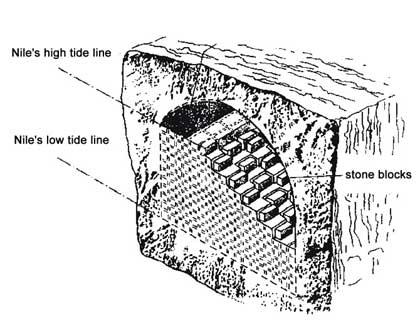
After the stone blocks were cut, boats were tied onto the stones and transported when the tides were high.
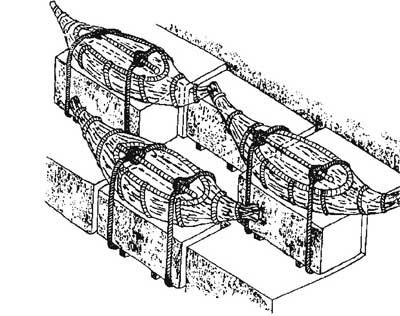
The stones were moved to the west part where the river’s water usually moved out of the river channel into the fields. The stones were left there and moved when the water had receded. It has been argued that during the floods, water could move very close to the construction sites of most of the pyramids. This is thought to have made the work of transporting the stone blocks quite easy.
On the land, the stone blocks were moved with the help of some form of a fulcrum. According to Bochnacki (2006), statues were moved by this means.
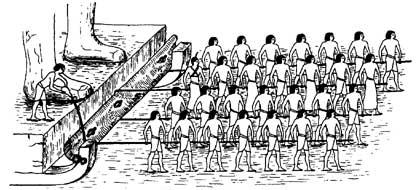
Bochnacki (2006) went on to explain how the blocks must have been moved up the ramps. Stone blocks were placed next to each and with the use of wooden levers and wedges they were moved up the ramps.
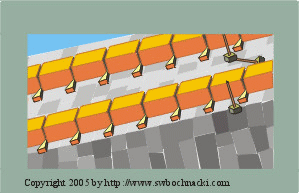
Bochnacki (2006) also suggested a means which was used to raise the stone blocks up the pyramid with the use of hoisting machines.
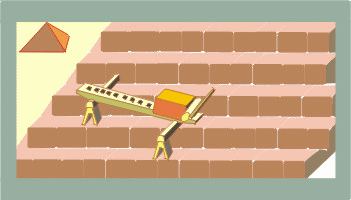
The Convincing Theory
I find the theory suggested by Bochnacki (2006) to be more convincing. There are a number of reasons for this as explained below.
- The transportation theories as suggested by Bochnacki (2006) make a comprehensive explanation on the most mysterious aspect of pyramid construction, that is, how the huge stone were moved. The explanation given from how the stones were picked with the help of floods from the quarries to how they were hoisted to the upper levels of the pyramid using hoisting machines make some sense to me.
- Bochnacki (2006) made a lot of calculation to back up some of the proposals he made. For instance, the fulcrum that he proposed that must have been used to move blocks of stones on land is supported by mathematical calculations to show how it must have worked. This makes this theory more convincing because the suggestions made are practical and therefore they probably occurred. He also throws in convincing remarks on how the workers were able to evade the strong sun rays and high temperatures while working by putting in place 100 blocks on a daily basis.
- Despite these comprehensive of proposal by Bochnacki (2006), there are still some unexplained mysteries. For instance, recent discoveries showed that some of the stone blocks used in the pyramid construction were cast (Barsoum & Ganguly, 2006). This means that they were not actually transported there but rather were made there.
Conclusion
The mystery of pyramid construction is still far from being solved. The Inside-Out theory suggests that the Great Pyramid was constructed starting from its central part towards the outer. Transportation theories suggested by Bochnacki (2006) try to explain how the huge stone blocks were move from the quarries, over the land and up the pyramids. More studies still reveal more secrets about the construction process making it even harder to understand how these huge structures were constructed. Despite the best efforts which have been put forth to explain the construction of pyramids, their construction still remain to be a mystery.
References
Barsoum, M. W., & Ganguly. A. (2006). Microstructural Evidence of Reconstituted Limestone Blocks in the Great Pyramids of Egypt. Journal of American Ceramics Society, 89(12), 3788-3796.
Bochnacki, A. (2006). A New Slant on the Pyramids. World Mysteries. Web.
GEP. (n.d). Dimension and Mathematics of the Great Pyramid. Global Education Project. Web.
Handwerk, B. (2008). Great Pyramid Mystery to be Solved by Hidden Room? National Geographic. Web.